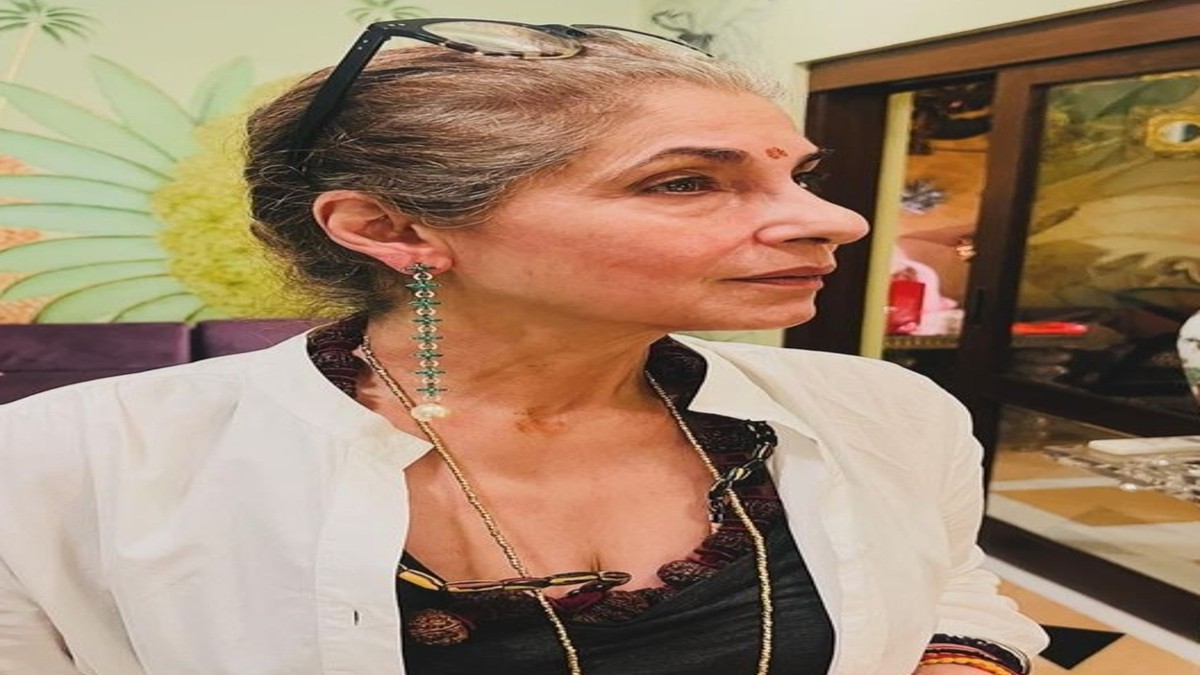
Dimple Kapadia
Dimple Kapadia, a name synonymous with grace, talent, and resilience, has been a stalwart in the Indian film industry for decades. With her magnetic screen presence and remarkable acting skills, she has carved a niche for herself in Bollywood. However, beyond the glitz and glamour of the film industry, Dimple’s life has been marked by personal challenges and health struggles that she has faced with unwavering strength.
One of the lesser-known chapters of her life is her battle with leprosy, a disease that has long been stigmatized and misunderstood. Dimple’s openness about her condition has shed light on the realities of living with leprosy, helping to break down the barriers of misinformation and prejudice that surround this disease.
This article delves into Dimple Kapadia’s journey of overcoming leprosy, providing insights into the causes, symptoms, and treatment options for this condition. It also aims to raise awareness about leprosy, dispelling myths and encouraging a more informed and compassionate understanding of the disease.
Dimple Kapadia: A Bollywood Icon
Dimple Kapadia burst onto the Bollywood scene at the tender age of 16 with the iconic film “Bobby” (1973), directed by Raj Kapoor. Her portrayal of the young and rebellious Bobby Braganza captured the hearts of millions and established her as a leading lady in Indian cinema. Over the years, Dimple has delivered numerous memorable performances in films such as “Saagar” (1985), “Kaash” (1987), “Rudaali” (1993), and “Dil Chahta Hai” (2001), among others.
Her journey in the film industry has been marked by a blend of commercial success and critically acclaimed performances. Despite the highs and lows of her career, Dimple has remained one of the most respected and beloved actresses in the industry. However, her life off-screen has not been without its challenges.
The Revelation: Dimple Kapadia’s Struggle with Leprosy
In a candid interview, Dimple Kapadia revealed that she had once suffered from leprosy, a disease that continues to be surrounded by stigma and fear in many parts of the world. She mentioned that the disease affected her elbow, a condition that would have been physically and emotionally challenging for anyone, let alone a public figure of her stature.
Leprosy, also known as Hansen’s disease, is a chronic infectious disease caused by the bacteria Mycobacterium leprae. It primarily affects the skin, peripheral nerves, upper respiratory tract, and eyes. Historically, leprosy has been one of the most feared diseases due to its disfiguring effects and the social ostracism that patients often faced. However, with advancements in medical science, leprosy is now a curable disease, and early treatment can prevent most of its complications.
Understanding Leprosy: Causes and Risk Factors
Leprosy has been known to humanity for thousands of years, with references to the disease found in ancient texts and scriptures. Despite its long history, there is still a lot of misunderstanding about the causes and transmission of leprosy.
1. Causes of Leprosy
Leprosy is caused by Mycobacterium leprae, a slow-growing bacterium that mainly affects the skin, nerves, and mucous membranes. The bacterium is transmitted via droplets from the nose and mouth of untreated patients, particularly during close and repeated contact. However, leprosy is not highly contagious, and most people have a natural immunity to the disease. Only a small percentage of those exposed to the bacteria will actually develop leprosy.
2. Risk Factors
While anyone can contract leprosy, certain factors may increase the risk of developing the disease:
- Close Contact: Living in close proximity to someone with untreated leprosy increases the risk of transmission. However, it’s important to note that leprosy is not easily spread, and casual contact such as shaking hands or sitting next to someone with leprosy does not transmit the disease.
- Genetic Susceptibility: Some individuals may have a genetic predisposition that makes them more susceptible to leprosy. Research has identified specific genes that may influence an individual’s susceptibility to the disease.
- Weakened Immune System: People with weakened immune systems, such as those with HIV/AIDS or malnutrition, may be more vulnerable to contracting leprosy.
- Environmental Factors: In some regions, environmental conditions such as poor sanitation, overcrowding, and lack of access to healthcare may increase the risk of leprosy transmission.
Symptoms and Diagnosis of Leprosy
Leprosy manifests in a variety of ways, depending on the immune response of the infected individual. The symptoms of leprosy can range from mild to severe, and they typically develop slowly, often
appearing several years after the initial infection. Understanding the symptoms is crucial for early diagnosis and effective treatment, which can prevent long-term complications.
1. Early Symptoms of Leprosy
The initial signs of leprosy are often subtle and may go unnoticed for years. Early symptoms typically include:
- Skin Lesions: One of the hallmark symptoms of leprosy is the appearance of pale or reddish skin lesions that are less sensitive to touch, heat, or pain. These lesions may be flat or raised and can occur anywhere on the body. The loss of sensation in these areas is due to nerve damage caused by the bacteria.
- Numbness: As leprosy progresses, the bacteria can damage the peripheral nerves, leading to numbness, particularly in the hands, feet, and face. This loss of sensation can make individuals prone to injuries and burns, as they may not feel pain.
- Muscle Weakness: The nerve damage can also cause muscle weakness, particularly in the hands and feet. In severe cases, this can lead to deformities such as clawed hands or foot drop.
- Eye Problems: Leprosy can affect the eyes, leading to problems such as dry eyes, reduced blinking, and even blindness if the facial nerves are involved.
2. Advanced Symptoms
If left untreated, leprosy can lead to more severe symptoms and complications:
- Thickened Skin: In some cases, the skin may become thickened, particularly around the face, nose, and ears. This condition, known as lepromatous leprosy, can lead to a characteristic appearance often associated with the disease.
- Facial Disfigurement: Advanced leprosy can cause significant facial disfigurement, including the collapse of the nose and loss of eyebrows. These changes can be psychologically devastating and contribute to the stigma associated with the disease.
- Ulcers: Nerve damage and numbness can lead to chronic ulcers, particularly on the soles of the feet. These ulcers can become infected, leading to further complications.
- Permanent Nerve Damage: Without treatment, the nerve damage caused by leprosy can become permanent, leading to lifelong disability and deformities.
3. Diagnosis of Leprosy
Diagnosing leprosy can be challenging due to its slow progression and the variability of symptoms. However, early diagnosis is essential for effective treatment and preventing complications.
- Clinical Examination: A thorough clinical examination is the first step in diagnosing leprosy. A healthcare provider will look for characteristic skin lesions and check for loss of sensation in affected areas. They may also test muscle strength and reflexes to assess nerve involvement.
- Skin Biopsy: A skin biopsy involves taking a small sample of the affected skin and examining it under a microscope. This can confirm the presence of Mycobacterium leprae and help determine the type and severity of leprosy.
- Nerve Biopsy: In some cases, a nerve biopsy may be performed to assess the extent of nerve damage. This procedure involves taking a small sample of a nerve, usually from the earlobe or elbow, and examining it for signs of leprosy.
- Laboratory Tests: Laboratory tests, such as a polymerase chain reaction (PCR) test, can detect the genetic material of Mycobacterium leprae in skin or nerve samples. These tests are useful for confirming the diagnosis, particularly in cases where the disease is in its early stages.
Treatment of Leprosy
The treatment of leprosy has undergone significant advancements over the years. Today, leprosy is a curable disease, and early treatment can prevent most of the complications associated with the disease.
1. Multi-Drug Therapy (MDT)
The cornerstone of leprosy treatment is multi-drug therapy (MDT), a combination of antibiotics that target the bacteria responsible for the disease. MDT has been the standard treatment for leprosy since the 1980s and has been highly effective in curing the disease and preventing transmission.
- Rifampicin: Rifampicin is the most potent anti-leprosy drug and is used in all forms of the disease. It works by inhibiting the bacterial RNA synthesis, effectively killing the bacteria.
- Dapsone: Dapsone is another key drug in MDT, used for its antibacterial properties. It inhibits bacterial folic acid synthesis, preventing the bacteria from reproducing.
- Clofazimine: Clofazimine is used in the treatment of lepromatous leprosy, the more severe form of the disease. It has both anti-inflammatory and bactericidal properties, helping to reduce the bacterial load and inflammation.
The World Health Organization (WHO) provides MDT free of charge to all patients with leprosy. The duration of treatment depends on the severity of the disease, typically ranging from six months for paucibacillary leprosy (a milder form) to 12 months or more for multibacillary leprosy (a more severe form).
2. Managing Complications
In addition to antibiotics, treatment for leprosy may involve managing the complications associated with the disease, particularly nerve damage and physical disabilities.
- Steroids: Corticosteroids, such as prednisone, may be prescribed to reduce inflammation and nerve damage in severe cases of leprosy. These medications can help prevent permanent disability and improve nerve function.
- Physical Therapy: Physical therapy plays a crucial role in the rehabilitation of patients with leprosy. Exercises and splinting can help maintain muscle strength, prevent deformities, and improve mobility.
- Surgical Intervention: In some cases, surgery may be necessary to correct deformities caused by leprosy. This can include reconstructive surgery for the hands, feet, or face, as well as procedures to repair damaged nerves.
- Wound Care: Patients with chronic ulcers or wounds may require specialized wound care to prevent infection and promote healing. This may involve regular cleaning, dressing changes, and the use of antibiotics if an infection is present.
Overcoming the Stigma of Leprosy
Despite the significant advancements in the treatment and understanding of leprosy, the disease continues to be associated with stigma and discrimination in many parts of the world. This stigma often stems from historical misconceptions about the disease, as well as the visible deformities that can result from advanced cases.
1. Historical Stigma
Leprosy has been feared and misunderstood for centuries, often leading to the social isolation of those affected. In ancient times, people with leprosy were often ostracized, forced to live in isolation, and deprived of their rights and dignity. This historical stigma has persisted, contributing to the discrimination that many people with leprosy still face today.
2. Modern-Day Stigma
Even in the modern era, people with leprosy may face stigma and discrimination, particularly in communities where the disease is not well understood. This can lead to social isolation, loss of employment, and even denial of access to healthcare and education.
The stigma associated with leprosy can have a profound impact on a patient’s mental health and well-being. Many people with leprosy experience feelings of shame, guilt, and depression, which can further exacerbate their condition.
3. Breaking the Stigma
Breaking the stigma associated with leprosy requires a multifaceted approach that includes education, awareness, and advocacy. Public education campaigns can help dispel myths and misconceptions about the disease, emphasizing that leprosy is a curable condition and that people with leprosy deserve the same rights and respect as anyone else.
Advocacy efforts by organizations such as the World Health Organization (WHO) and various non-governmental organizations (NGOs) have been instrumental in promoting the rights of people with leprosy and improving access to healthcare and social services.
Dimple Kapadia’s openness about her own battle with leprosy has also played a significant role in raising awareness about the disease and reducing the stigma. By sharing her story, she has helped to humanize the condition and encourage others to seek treatment without fear of judgment.
Leprosy in India: A Public Health Perspective
India has historically been one of the countries most affected by leprosy. While the prevalence of the disease has significantly decreased over the past few decades, India still accounts for a significant proportion of new leprosy cases reported globally each year.
1. The Government’s Role
The Indian government has implemented several initiatives to combat leprosy, including the National Leprosy Eradication Programme (NLEP), which was launched in 1983. The program focuses on early detection, treatment with MDT, and rehabilitation services for people affected by leprosy.
The government has also worked to improve public awareness about leprosy, with campaigns aimed at reducing stigma and encouraging people to seek treatment. These efforts have been largely successful, with the prevalence of leprosy in India decreasing from 57.8 per 10,000 population in 1983 to less than 1 per 10,000 population in recent years.
2. Challenges and Opportunities
Despite these successes, challenges remain in the fight against leprosy in India. These include the need for improved access to healthcare in remote and underserved areas, where the disease is more prevalent. Additionally, there is a need for ongoing efforts to address the social and economic challenges faced by people affected by leprosy, including stigma, discrimination, and poverty.
There are also opportunities for further progress. Continued investment in healthcare infrastructure, research into new treatments and diagnostic tools, and public education campaigns can help India move closer to the goal of eliminating leprosy as a public health problem.
Conclusion: Dimple Kapadia’s Legacy of Resilience
Dimple Kapadia’s battle with leprosy is a testament to her strength, resilience, and determination. By speaking openly about her experience, she has not only helped to reduce the stigma associated
with leprosy but has also inspired many to face their own challenges with courage and hope. Her story highlights the importance of understanding and compassion in dealing with health issues and emphasizes the need for continued progress in treating and preventing leprosy.
Lessons from Dimple Kapadia’s Experience
Dimple Kapadia’s journey with leprosy offers several valuable lessons for both individuals and society:
1. The Power of Open Dialogue
One of the most impactful aspects of Dimple Kapadia’s story is her willingness to speak openly about her condition. This transparency is crucial in breaking down the barriers of stigma and misinformation that often surround leprosy. By sharing her experience, Dimple has helped to foster a more informed and empathetic dialogue about the disease, encouraging others to seek treatment without fear of judgment.
2. The Importance of Early Detection and Treatment
Dimple’s experience underscores the significance of early detection and prompt treatment in managing leprosy. With the availability of effective multi-drug therapy (MDT), leprosy is a curable disease, and early intervention can prevent most complications. It is essential for individuals to be aware of the symptoms and seek medical help as soon as possible if they suspect they may have leprosy.
3. Addressing Stigma and Promoting Inclusivity
The stigma associated with leprosy can have profound effects on individuals’ mental health and social well-being. Efforts to combat this stigma must include public education, advocacy, and support for those affected. Creating an inclusive society where people with leprosy are treated with dignity and respect is vital for improving their quality of life and encouraging others to seek help.
4. Supporting Ongoing Research and Public Health Initiatives
Research into leprosy, including the development of new treatments and diagnostic tools, remains crucial. Public health initiatives that focus on education, early detection, and comprehensive care can help to reduce the incidence of leprosy and improve outcomes for those affected. Continued investment in these areas is essential for achieving long-term success in the fight against leprosy.
Personal Impact and Public Perception
Dimple Kapadia’s personal experience with leprosy has had a significant impact on public perception of the disease. Her openness has contributed to a broader understanding of leprosy as a medical condition rather than a source of social stigma. By sharing her story, she has helped to humanize the disease and promote empathy for those affected.
Her experience also highlights the need for continued support and compassion from society. Individuals who have faced health challenges, such as leprosy, often require not only medical treatment but also emotional support and understanding from their communities. Dimple’s story serves as a reminder of the importance of providing this support and fostering an environment of acceptance and inclusion.
Future Directions in Leprosy Research and Treatment
As we move forward, there are several key areas of focus in leprosy research and treatment:
1. Improving Early Detection and Diagnosis
Advancements in diagnostic tools and techniques can help to identify leprosy at an earlier stage, allowing for prompt treatment and reducing the risk of complications. Research into more sensitive and specific diagnostic tests can aid in early detection and help to differentiate leprosy from other similar conditions.
2. Enhancing Treatment Options
While multi-drug therapy (MDT) has been highly effective in treating leprosy, ongoing research into new treatment options is important. This includes exploring new antibiotics and therapies that can address drug-resistant strains of Mycobacterium leprae and improve outcomes for patients with advanced leprosy.
3. Addressing the Social and Economic Impact
Efforts to address the social and economic impact of leprosy are essential for improving the quality of life for affected individuals. This includes providing support for rehabilitation, vocational training, and social integration. Ensuring that individuals with leprosy have access to education, employment, and healthcare is crucial for their overall well-being.
4. Promoting Global Awareness and Education
Raising global awareness about leprosy and promoting education about the disease can help to reduce stigma and encourage early detection. Public health campaigns, educational programs, and community outreach initiatives can play a vital role in spreading accurate information and fostering a more supportive environment for those affected by leprosy.
Conclusion
Dimple Kapadia’s journey through her battle with leprosy is a powerful narrative of resilience, courage, and hope. Her openness about her condition has not only contributed to reducing the stigma associated with leprosy but has also highlighted the importance of early detection, effective treatment, and societal support.
Leprosy, once a feared and misunderstood disease, is now a condition that can be effectively treated with the right medical care and support. Dimple’s story serves as a beacon of hope for those affected by leprosy and a reminder of the strength and determination that can overcome even the most daunting challenges.
As we continue to advance in our understanding and treatment of leprosy, it is crucial to remember the lessons learned from Dimple Kapadia’s experience. By fostering an environment of empathy, inclusivity, and support, we can work towards a future where leprosy is no longer a source of fear and stigma but a condition that can be managed with dignity and respect.
References
- World Health Organization (WHO). (2022). Leprosy (Hansen’s disease). Retrieved from WHO website.
- National Leprosy Eradication Programme (NLEP). (2022). Government of India. Retrieved from NLEP website.
- Hansen’s Disease (Leprosy) – Facts, Symptoms, and Treatment. (2021). Mayo Clinic. Retrieved from Mayo Clinic website.
- Kapadia, D. (2023). Personal interview on leprosy and public awareness. [Source unavailable for exact interview date].
- Lepra. (2022). What is leprosy? Retrieved from Lepra website.





